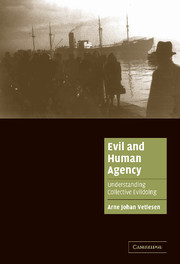Book contents
- Frontmatter
- Contents
- Preface
- A note on the cover image
- Introduction
- 1 The ordinariness of modern evildoers: a critique of Zygmunt Bauman's Modernity and the Holocaust
- 2 Hannah Arendt on conscience and the ‘banality’ of evil
- 3 The psycho-logic of wanting to hurt others: An assessment of C. Fred Alford's work on evil
- 4 The logic and practice of collective evil: ‘ethnic cleansing’ in Bosnia
- 5 Responses to collective evil
- 6 A political postscript: globalization and the discontents of the self
- References
- Index
- Evil and human agency
Introduction
Published online by Cambridge University Press: 10 December 2009
- Frontmatter
- Contents
- Preface
- A note on the cover image
- Introduction
- 1 The ordinariness of modern evildoers: a critique of Zygmunt Bauman's Modernity and the Holocaust
- 2 Hannah Arendt on conscience and the ‘banality’ of evil
- 3 The psycho-logic of wanting to hurt others: An assessment of C. Fred Alford's work on evil
- 4 The logic and practice of collective evil: ‘ethnic cleansing’ in Bosnia
- 5 Responses to collective evil
- 6 A political postscript: globalization and the discontents of the self
- References
- Index
- Evil and human agency
Summary
Some fifteen years ago, just after the end of the cold war, Leonard Cohen contended, ‘I have seen the future. It is murder.’
He has been proved right. Not that human evildoing is something new; far from it. If anything, what is new is the readiness of society to denounce large-scale atrocities whenever they occur and to indict those responsible, as demonstrated by the UN Conventions inspired by the ‘Never again!’ unanimously voiced in the aftermath of the Holocaust.
Now take a look at what happened during the last decade of the twentieth century – the century that will go down in history as the century of (increasingly universal) human rights and as a century stained by genocide. The facts are as plain as they are deeply disturbing: the 1990s saw the slaughter of more than 800,000 people within three months in Rwanda, as well as the murder of nearly 200,000 people in the former Yugoslavia. In the former case, the victims were massacred with machetes, axes, and kitchen tools; in the latter, with guns, knives, and broken bottles. The principal victims were civilians, of both sexes and all ages. The atrocities were not carried out in secrecy; on the contrary, they were reported live on television for months on end. Despite the knowledge – or perversely, partly because of it, as I shall argue – not much was done to stop the genocides.
- Type
- Chapter
- Information
- Evil and Human AgencyUnderstanding Collective Evildoing, pp. 1 - 13Publisher: Cambridge University PressPrint publication year: 2005



